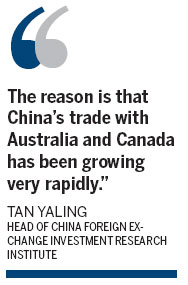New onshore partners for yuan trading
Updated: 2011-11-29 07:51
By Li Xiang (China Daily)
|
|||||||||
Analysts see low volumes initially, but expect expansion as use grows
BEIJING - China on Monday started trading the yuan against the Australian and Canadian dollars in the domestic interbank foreign-exchange market.
However, they expect the volume to increase gradually as the use of the yuan expands in the global markets.
During recent years, China has been seeking to expand the use of the yuan in global trade and investment, and to enrich trading products in the domestic market. The trading of the two new currency pairs comes in the wake of China adding trading of the Malaysian ringgit and the Russian rouble to the domestic foreign-exchange market in 2010.
|
|
The yuan is currently traded onshore against nine major currencies, including the US dollar, the euro, the British pound, and the yen. The move to approve the trading of the Australian and Canadian dollar onshore is being interpreted as part of Beijing's efforts to reduce reliance on the US dollar and to raise its currency's profile in international trade and investment.
"The reason is that China's trade with Australia and Canada has been growing very rapidly. There is also a high probability that the two currencies will appreciate in the future," said Tan Yaling, head of the China Foreign Exchange Investment Research Institute.
Trading products of the yuan against the new currencies will include spot and forward trading and currency swaps, according to the China Foreign Exchange Trade System (CFETS).
The pricing of the yuan trading against the Australian and Canadian dollars is based on a midpoint set by the Chinese central bank, with a fluctuation range of 3 percent, according to CFETS.
Tian Xiaoge, an analyst at Hang Seng Bank Ltd, said that the market is likely to respond positively to these new trading products as the nation's trading relationships with Australia and Canada are becoming increasingly close because of China's huge demand for natural resources.
Meanwhile, the Bank of Thailand announced last week that it will add the yuan to its basket of foreign-exchange reserves, with an allocation of less than 1 percent. Thailand is the second country after Nigeria to announce the diversification of its foreign exchange reserves into the yuan.
Although the Chinese currency not freely convertible under the capital account, the government is eager to develop Hong Kong into key hub for the offshore yuan in order to raise the global profile of the currency. Some analysts forecast that yuan deposits in Hong Kong are likely to reach 2 trillion yuan ($312 billion) by 2014.
















